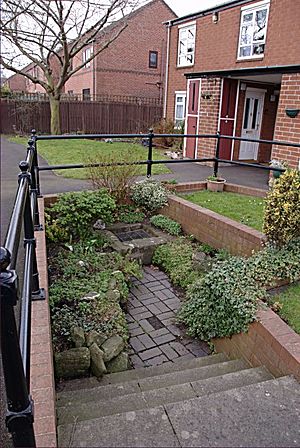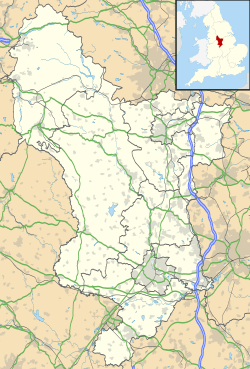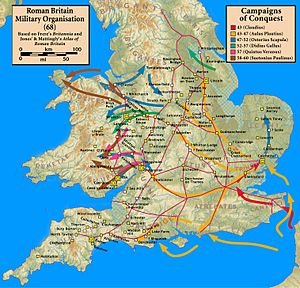Derventio Coritanorum facts for kids

This Roman well dates back to the late 3rd century, Derventio lies behind the houses
|
|
| Location | Derby, Derbyshire |
|---|---|
| Region | East Midlands |
| Coordinates | 52°56′01″N 1°28′25″W / 52.933735°N 1.473586°W |
| Type | Roman fort |
| Part of | Icknield Street |
| History | |
| Founded | about AD 80 |
| Abandoned | about AD 120 (but settlement continued) |
| Site notes | |
| Website | Derventio (Coritanorum) at Roman Britain |
| PastScape | |
Derventio was a small town in the Roman province of Britannia. Today, this area is known as Little Chester. It is located on the edge of Derby in the English county of Derbyshire.
Contents
What Was Derventio?
Derventio was an important Roman fort and settlement. It played a role in the Roman control of Britain. The Romans built forts to help them conquer and manage new lands.
Early Roman Forts in the Area
The first Roman fort near Derventio was built around Strutts Park. This was on the other side of the River Derwent. Around AD 80, the Romans built a new fort at the Derventio site. This new fort was used for about 40 years. After that, it was no longer needed as a fort.
Life and Industry in Derventio
Even after the fort was decommissioned, Roman activity continued. Derventio was connected by roads. One road went west to Icknield Street. Another went east to Sawley on the River Trent. A settlement grew 600 meters east of the fort. This settlement made pottery and worked with iron. It was an important center for trade and manufacturing.
Later Fort Use and Town Walls
The fort was later used again for about 25 years. Its defenses were rebuilt with timber and stone gates. Then, it was empty for a while. In the late 3rd century, a stone wall was built around the town. This wall helped protect the people living there. Derventio continued to be a town until the end of the 4th century.
Derventio Today
Today, a modern road called Old Chester Road cuts through the old fort site. In the 1800s, a railway line also went through part of it. These modern features show how the land has changed over time.
The History of Roman Britain and Derventio
Historians are not sure which local tribe lived in the Derby area. It was likely the Corieltauvi or Cornovii. In AD 46-47, the Roman Army probably took control of lands south of the River Trent. By AD 50, this area was the Roman front line. We don't have many written records from these early years. So, we learn a lot from archaeological digs.
Roman Governors and Campaigns
In AD 47, a new Roman governor named Ostorius Scapula arrived. He started campaigns against tribes in modern-day Wales. He also fought in the Cheshire Gap. During these times, Strutt’s Park Roman fort was built. It was part of a new supply road from Wroxeter to Rossington.
The fight to conquer the Silures tribe continued under later governors. These included Quintus Veranius and Gaius Suetonius Paulinus. By then, Strutt’s Park fort helped keep the peace. Around AD 74, lands north of the River Mersey became unstable. A queen named Cartimandus asked Rome for help.
Agricola's Influence
In AD 78, Gnaeus Julius Agricola became governor. His son-in-law, Tacitus, wrote a famous book about him. Agricola made Roman forts stronger and improved roads. He led important campaigns. In AD 78, he reconquered North Wales. In AD 79, he conquered the Brigantes and Parisii tribes. This brought all of Northern England under Roman control. Strutt's Park fort was left empty in AD 80. This is when Derventio was built.
Derventio's Role After AD 120
Derventio was used as a fort for 40 years, until about AD 120. Around this time, Emperor Hadrian visited Britain. He ordered the building of Hadrian's Wall. This wall marked the northern border of Roman Britain. Even though Britain always had many soldiers, the focus changed. It shifted towards making goods. Derby became known for its pottery. It also had access to lead mines in the Peak District. Later, it became a center for working with metals. This continued for the next 200 years.
See also
 In Spanish: Derventio (Little Chester) para niños
In Spanish: Derventio (Little Chester) para niños



